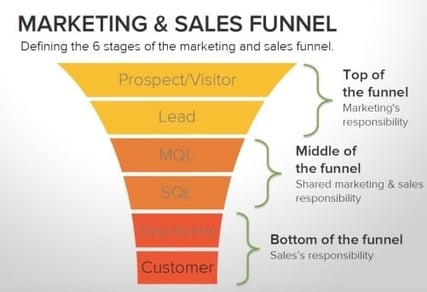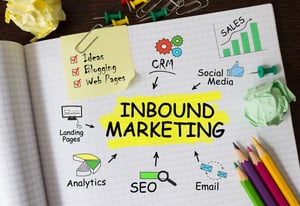
Actually, everything about inbound marketing is not about sales. They are very separate crafts – but when they’re combined, they can both be fire. In the past, marketing and sales have worked together about as well as glue and water. The creative planners in marketing see benefits in social media and advertising versus the sales extroverts who would rather connect with people in the real world. That's one of the reasons sales and marketing work independently. But in all reality, reaching your company's true potential comes by unifying these departments. How can you do this and jump on the bandwagon that forward-thinking sales people are embracing? Inbound is the answer.
BRIDGING THE GAP
The marketing and sales funnel used in the inbound process shows  that marketing is responsible for the top of funnel and sales for the bottom. Getting potential customers through this funnel is the responsibility of both departments. It’s important to have clarity between sales and marketing as a marketing qualified lead (MQL) transitions to a sales qualified lead (SQL).
that marketing is responsible for the top of funnel and sales for the bottom. Getting potential customers through this funnel is the responsibility of both departments. It’s important to have clarity between sales and marketing as a marketing qualified lead (MQL) transitions to a sales qualified lead (SQL).
In order to track prospects, MQLs, and SQLs at Leighton Interactive, we utilize workflows to track the buyer's journey of our clients' prospects. They allow us to ensure that both parties are on the same page, so sales can nurture the prospect in a way that fits the insights marketing has gathered.
Software like HubSpot gives us the ability to look at the actions visitors are taking on a website, social account, or email, and track them. These insights show us where the person is in the buyer's journey and what steps need to be made in order to nurture them to the next phase. Workflows are also set up to analyze customer behaviors and actions after a sale. This information gives us an understanding on their intentions and interests after reaching the bottom of the funnel and how to stay connected with them. However, bridging this gap won't be successful unless both marketing and sales are working towards the same goal.
SALES + MARKETING = SMARKETING
Smarketing, can be defined in less than 100 words - it brings together the marketing and sales departments to align them around the same measurable goals. It was created by Dan Tyre, Hubspot employee #6 and one of our keynote speakers from One Squared 2016. The simple solution to keeping these two on the same page? Sharing data, and every piece of it. Smarketing helps both teams share data on warm leads, engagement, and ROI. If you have a CRM integration (Sales Force) with HubSpot - it will do all of that for you. The key here is for the sales and marketing teams to have a common integrated approach, and for this to happen you will need a written agreement between the two teams on responsibilities and accountability. Need a template? Check out our favorite here.
So, why should your sales team use smarketing and inbound? Sales is known for being a competitive industry that focuses on a "number" and is based upon a monetary incentive. The sales people who are able to put this aside are the ones embracing inbound marketing and smarketing. Be the first in your business to become a smarketer - bring ideas about what your marketing and sales team should be talking about and how they can work together. Using strategies like account-based marketing (ABM) and personalized video, smarketing provides an opportunity for your business to become an even stronger force to be reckoned with.
Opportunities for Sales Teams
Open-minded sales people utilizing inbound marketing are seeing the benefits - they're gaining insider intelligence about their customers and they're keeping quiet about it. This is because inbound is just different - it tracks and analyzes every action a user has the second they start interacting on a website. Kinda creepy, right? But it works. It gives your sales team an opportunity to connect with people they are missing out on - people who show interest in understanding your business by consuming your content.
Sales content can have perfect timing - but sales people can’t. With an inbound approach you will understand why and how a person acts and thinks instead of running blindly with a sales pitch. When it comes to sales and benefits for your sales team; gaining insight on current and potential customers will help with current and future selling strategies.
 The inbound marketing methodology provides more information about your prospects, leads, and customers to make traditional sales efforts more productive. Your sales team has an opportunity to gain in-depth insight into who they should be targeting and how through smarketing, workflows, and inbound. By being aware of what's going on in the top of the funnel, your team will ultimately close more deals as well as the loop between marketing and sales.
The inbound marketing methodology provides more information about your prospects, leads, and customers to make traditional sales efforts more productive. Your sales team has an opportunity to gain in-depth insight into who they should be targeting and how through smarketing, workflows, and inbound. By being aware of what's going on in the top of the funnel, your team will ultimately close more deals as well as the loop between marketing and sales.
